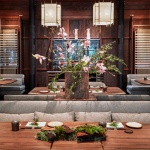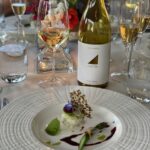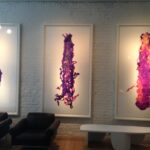
Was there a moment that you remember when you knew that you wanted to be a winemaker?
I do – I remember working my first harvest at De Loach Vineyards and meeting everyone from the winemaking side, hospitality, vineyard and even the maintenance side. Everybody loved what they did and I couldn’t believe one industry could support so many job positions. Plus I was intrigued by watching people taste the wine and see their eyes light up and spark a conversation. I thought the process of making wine in the cellar was so cool, I was sold.
What was your first wine job?
First job was in 1996 after graduating from Healdsburg High at De Loach Vineyards. I met with the winemaker, told him I wanted to clean and I got the cellar rat job. Go figure. Big’ol $7.50/ hour too.
I know over the years you’ve worked at Copain and Goldeneye? What led to you leaving those brands and starting your own brands.
I left Goldeneye because I wanted to move up in the winemaking team but there was no sign of someone moving on. Working for Duckhorn/Goldeneye is a sweet gig so it would have been a while until that was possible. Plus I was approached to work at Copain, which I jumped on. The wine style of Copain was on point and was making what I call, “winemaker wines.” I also knew that all of Copain’s assistants had started their own brands while working there so I felt THIS could be my springboard. Ultimately I had to pay my dues and in 2014, I started Rootdown. After the sale of Copain to Kendal Jackson in 2016 and the traction I was getting with Rootdown combined with some confidence, I felt it was time to see what was possible. After 18 harvest making wine for others, I had the “why not” bug.
Speaking of your brands, you currently have 3: Rootdown, Cole Ranch & Es Okay. Can you share more about each brand’s personality and wine varietals?
Certainly:
Rootdown – “It’s what the vine drinks”. Playful, organic, true, single-vineyard/variety yet serious. Currently, we produce: Pinot Blanc, Chenin Blanc, Grenache Blanc; Rosé of Trousseau, Rosé of Sangiovese; Trousseau (carbonic), Sangiovese, Mourvèdre and Pinot Noir. But here comes the Reeeeeemiiiiiix. We’ve grafted 6 acres at Cole ranch to Rootdowns future. In a few years Rootdown will solely be a Jura inspired brand. Varieties will be Trousseau, Poulsard, Pinot Noir, Chardonnay and Savagnin. I want these wines to be affordable, serious but with some gems, in there that will be a playground for some winemaking experiments.
Cole Ranch – “The OG.” Heritage, original, old school, classy, structured. This brand is like the guy who says, “When I was your age……” Here I want to respect what John Cole planted back in ’73. I’d like to embrace the difficulty of the Merlot and Cabernet growing in this cooler, high elevation site. Cole Ranch brand is 100% Riesling, Merlot, and Cabernet from America’s smallest appellation called Cole ranch.
Es Okay – “The first rule of Es Okay is that we don’t talk about Es Okay” Here we wanted to help growers find a home for unspoken fruit. Just turns out that what we found was better than OK. This is our smart ass, fuck it lets do it wine. The 2019 white is a blend of Pinot Blanc, Chenin Blanc, Grenache Blanc and Riesling. The Red is a blend of Portuguese grapes. Think Touriga National and a few Tintas.
Cole: This is a brand that will probably come out in 4-5 years. Think Savoie…..
When we met and you shared with me you recently acquired Cole Ranch AVA, an American Viticultural Area located in Mendocino County, California. At less than a quarter of a square mile, it is the smallest appellation in the United States. What do you plan to do with Cole Ranch? What is it like owning an AVA that’s pretty cool and unique?
Unique it is indeed. To be honest, when you ask what it is like? It really hasn’t sunken in yet. Except for the brutal truth that I have a huge responsibility and some funny expectations. BUT! This is our plan: The end game is to turn Cole Ranch into an Alpine site that it deserves. So for us, this means planting grapes from the Jura and Savoie. We have an open mind to working with other winemakers that would like to graft or plant a row (or 2) to Alpine varieties with the hopes to maintain diversity and conversation. We will produce wine from 40-50% of the Ranch and sell the remaining is our thought. We’re also transitioning the entire ranch to a more bio-diverse approach. Once we nail down our organic program, we’ll lean towards biodynamics and livestock.
Can you share more stylistically about your winemaking style?
Stylistically its hands off……..until I need to intervene. The wines are Natural – meaning no yeast, no secondary culture, no So2 at the crush pad, less than or equal to the amount of sulfur found on the vine added at bottling and organic. Wines must have energy, lower alcohol, great acidity and approachable tannins. I don’t use any technology or refrigeration on the wines but I do filter since I’m not using a preservative (so2). Wines have no new oak and are bottled within 10 months to preserve freshness and varietal character.
What is something you’d like to share about California’s Wine Country that many consumers may not know?
I feel that most aren’t aware about how difficult it is to put yourself out there and put something they believe in, into a bottle. They should also know that the wine county is OPEN. The wine country employs people of every facet of a business. It truly is a cyclical industry. Despite all of our natural disasters and pandemic, we are open. Opening one bottle of wine pays someone’s bills.
What would you like to share about Healdsburg (where you call home) and the wine scene in this region?
Well. Healdsburg has changed since I was young. It used to be just us hippies, hicks, and tweakers (not me). And those do still exist, we’ve become a little bit more polished. Healdsburg has always been about hospitality and diversity. We are probably the least judgmental town. We believe in all things art and that brings culture and all walks of life. This is also what makes our wine scene so cool. We have historical vineyards that produce $200+ bottles of wine and $20 bottles of wine that will give you the same happiness. We have old school winemakers making Healdsburg classics and new Californian winemakers paving future Healdsburg classics. You can truly travel the world of wine in Healdsburg.
As a winemaker, you taste (and spit) lots of wine, what wine do you feel bad about spitting because you LOVE it so much?
Oooooo. Tough one. If it’s a Rootdown wine, I’d say it the Sangiovese. I think it’s because I never thought I’d make Sangiovese and I’m enjoying learning more about how it develops over time. An overall variety I have a hard time spitting out is Gamay. You can’t spit out Gamay.
What was one of the biggest mistakes you have made in your winemaking career?
Not traveling enough. I was lucky to get a great job out of college and didn’t take my degree overseas. I feel like I’m playing catch up right now.
Who has been the most influential mentor in your career?
Zack Rasmuson who was the winemaker at Goldeneye. I told him this at my exit interview: “I didn’t learn much stylistically or feel like I’m a better winemaker, but I do feel like you taught me how to manage myself and be better for other people.” He would say shit like, “be the winery” and “fear the forklift.” Non of his advise was going to make me be a better winemaker, but it somehow did.
What is your favorite after-work drink?
Water. We drink when we work.
What is your favorite local spot in Healdsburg?
I can’t single out one spot because we love to support everybody. Part of our diversity mentality. I do love a good hike to the top of Fitch Mountain though. Gives you a good perspective of our town.
Tell us something that would surprise people about you?
The college I got my Enology degree from tried to prevent me from graduating because of something I wrote and got printed in the SF Chronicle. Hell, the fact that I have a college degree should surprise people.
Also, I paint my toenails…………
























What do you think?